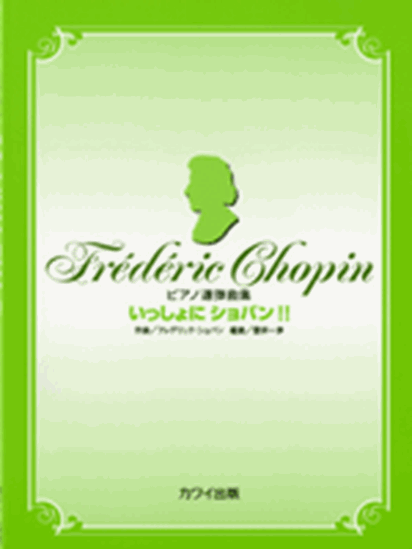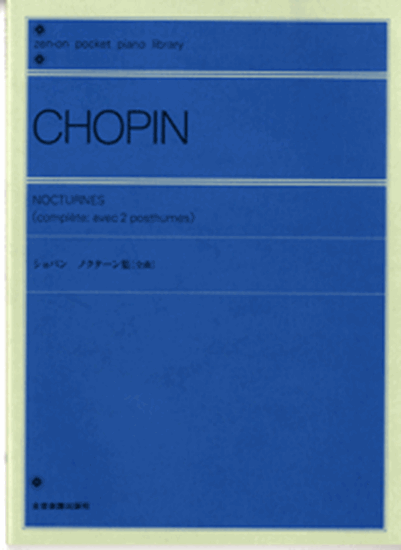Chopin, Frederic : Nocturne (lento con gran espressione) cis-moll KK.IVa/16
Work Overview
Publication Year:1875
First Publisher:Leitgeber
Instrumentation:Piano Solo
Genre:nocturne
Total Playing Time:4 min 00 sec
Copyright:Public Domain
Commentary (2)
Author : Hayashikawa, Takashi
Last Updated: January 1, 2010
[Open]
Author : Hayashikawa, Takashi
Nocturne cis-moll Op.posth.
A work completed in Vienna in 1830 and sent to Chopin's sister, Ludwika. It is conventionally counted as one of the nocturnes because it was listed as 'Lento in the style of a nocturne' in Ludwika's catalog of Chopin's unpublished works. It is presumed that Chopin himself did not name it a nocturne. For this reason, the tempo marking 'Lento con gran espressione' is often used as its title. The manuscript sent to Ludwika was later copied by Oskar Kolberg, a friend of Chopin's father, and an ethnographer and musician, and the first edition was published in 1875 based on this copy.
The piece, broadly speaking, follows an introduction-A-B-A'-coda structure. In the initial A section, the highly lyrical melody is striking, but the range between the lowest and highest notes of the melody spans three octaves and a semitone, making it impossible to sing in practice. Furthermore, chromatic harmony is subtly employed at the end of A, lending a delicate nuance.
The subsequent B section is divided into a first half, which continues with the same accompaniment pattern as A, and a second half, where the time signature changes to 3/4. Motifs from Chopin's own Piano Concerto No. 2 and his song 'The Maiden's Wish' are quoted.
Musical Example 1: Measures 23-24
Musical Example 2: Piano Concerto No. 2, 1st movement, Measures 41-42
Musical Example 3: Measures 21-23
Musical Example 4: Piano Concerto No. 2, 3rd movement, beginning
In the first half of this section, Chopin initially wrote the right hand in 3/4 time for two measures against one measure of 4/4 time in the left hand. However, perhaps deeming it too difficult, the manuscript sent to Ludwika features a simplified rhythm where both hands can be played in 2/2 time (Musical Example 3; this simplified version is usually performed, though some interpret this as Chopin's compromise and perform the original complex version).
Returning to A' and entering measure 53, just as the music seems to settle with a half cadence on V, the melody abruptly ascends, heightening the tension. When the bass descends to F## in the next measure, forming a diminished seventh chord, the tension reaches its peak. Between F# (the last note of the melody in measure 53) and F## (the first note of the left hand in measure 54), a cross-relation occurs, which is generally avoided in harmony (Musical Example 5).
Musical Example 5: Measures 50-52
Then, as the melody continues its descent and settles on the tonic (I), the accompaniment endlessly repeats two types of chords: the tonic and its neighboring chord. The right hand, as if muttering the same thing repeatedly, ascends and descends the scale four times, finally concluding with a Picardy third, suddenly shifting to the parallel major.
Author : Ooi, Kazurou
Last Updated: March 12, 2018
[Open]
Author : Ooi, Kazurou
Nocturne, Op. posth., C-sharp minor
Regarding this Nocturne, there are no particularly unique performance tips; instead, these are general points of caution.
- Between measures 1-2 and 3-4, it is advisable to play measures 3-4 slightly softer. Considering this, make measures 1-2 a slightly stronger pp. Throughout these four measures, the uppermost voice is crucial, so clearly bring out the melodic line.
- From measure 5 onwards, pay attention to balance. The left hand should be played as pp as possible. The accompaniment pattern in this Nocturne has notes on every beat. This means the music can easily become metrically rigid; if the beat is too pronounced, the music will sound vertical rather than flowing horizontally. The solution is to play the left hand as pp as possible, allowing for a performance where the beat is not overtly felt.
- At measure 11, the left-hand arpeggiated accompaniment pattern breaks for the first time, becoming more melodic. On the fourth beat, the right hand forms a third harmony with D-sharp and C-sharp. It would be beneficial to be aware of this.
- Measures 17-19 are a very dramatic section, featuring Neapolitan sixth and German augmented sixth chords. Be careful not to reduce the volume too much. On the second beat of measure 19, playing the A as if with difficulty can be effective.
- While different dynamics are desirable between measures 21-24 and 25-28, the performer should make one dynamic larger and the other smaller, based on their own interpretation and feeling. I do not believe it is strictly necessary to adhere to the ppp at the beginning of measure 21. The point is to consider which of the ppp at measure 21 or the sotto voce at measure 25 feels more piano.
- Measures 33-45, as some of you may know, are part of a piano concerto. Therefore, many pianists play this section at a faster tempo. Indeed, playing this section strictly in tempo might make it feel drawn out. Consider this section as one that evokes old memories.
- Measures 57-60 feature ascending and descending passages of small notes in the right hand. While some performers play this section ostentatiously at a furious speed, like a Liszt étude, there is absolutely no need to rush here.
Arrangements & Related Works(3)
PTNA & Partner Channel Videos(18items) View More
Reference Videos & Audition Selections(6items)
Sheet MusicView More
Scores List (59)
![やさしいピアノ名曲集3[発表会用/CD付]時代別編纂 - 楽譜表紙画像](https://ptna-assets.s3.ap-northeast-1.amazonaws.com/enc/books/45.jpg)
(株)エー・ティ・エヌ

(株)全音楽譜出版社

(株)ドレミ楽譜出版社

(株)音楽之友社

(株)ヤマハミュージックエンタテインメントホールディングス

(株)リットーミュージック

(株)ドレミ楽譜出版社

(株)シンコーミュージックエンタテイメント

(株)全音楽譜出版社

KMP(ケイ・エム・ピー) ケイエムピー

(株)シンコーミュージックエンタテイメント

(株)全音楽譜出版社

(株)ヤマハミュージックエンタテインメントホールディングス

(株)シンコーミュージックエンタテイメント

(株)全音楽譜出版社

ハンナ(ショパン)

(株)ヤマハミュージックエンタテインメントホールディングス

(株)ヤマハミュージックエンタテインメントホールディングス

(株)ヤマハミュージックエンタテインメントホールディングス

ジェスク音楽文化振興会

カワイ出版

ハンナ(ショパン)

(株)シンコーミュージックエンタテイメント

(株)シンコーミュージックエンタテイメント

KMP(ケイ・エム・ピー) ケイエムピー

(株)シンコーミュージックエンタテイメント

ハンナ(ショパン)

(株)リットーミュージック

(株)ドレミ楽譜出版社

(株)共同音楽出版社

ハンナ(ショパン)

(株)シンコーミュージックエンタテイメント

ハンナ(ショパン)

KMP(ケイ・エム・ピー) ケイエムピー

ハンナ(ショパン)

ハンナ(ショパン)

ハンナ(ショパン)

(株)シンコーミュージックエンタテイメント

(株)ドレミ楽譜出版社

(株)ドレミ楽譜出版社

(株)ドレミ楽譜出版社

デプロMP

(株)全音楽譜出版社

(株)シンコーミュージックエンタテイメント

(株)全音楽譜出版社

(株)全音楽譜出版社

(株)音楽之友社

(株)全音楽譜出版社

(株)全音楽譜出版社

(株)全音楽譜出版社

ポーランド音楽出版社

(株)ヤマハミュージックエンタテインメントホールディングス

(株)音楽之友社

(株)ヤマハミュージックエンタテインメントホールディングス

(株)ヤマハミュージックエンタテインメントホールディングス

Neil A. Kjos Music Company

Peters
















![ノクターン[夜想曲] 第20番 - 演奏動画のサムネイル](http://i.ytimg.com/vi/PXGgcRu-uTg/mqdefault.jpg)




![ノクターン[夜想曲]第20番 - 演奏動画のサムネイル](http://i.ytimg.com/vi/wJb_q1lcqHo/mqdefault.jpg)


